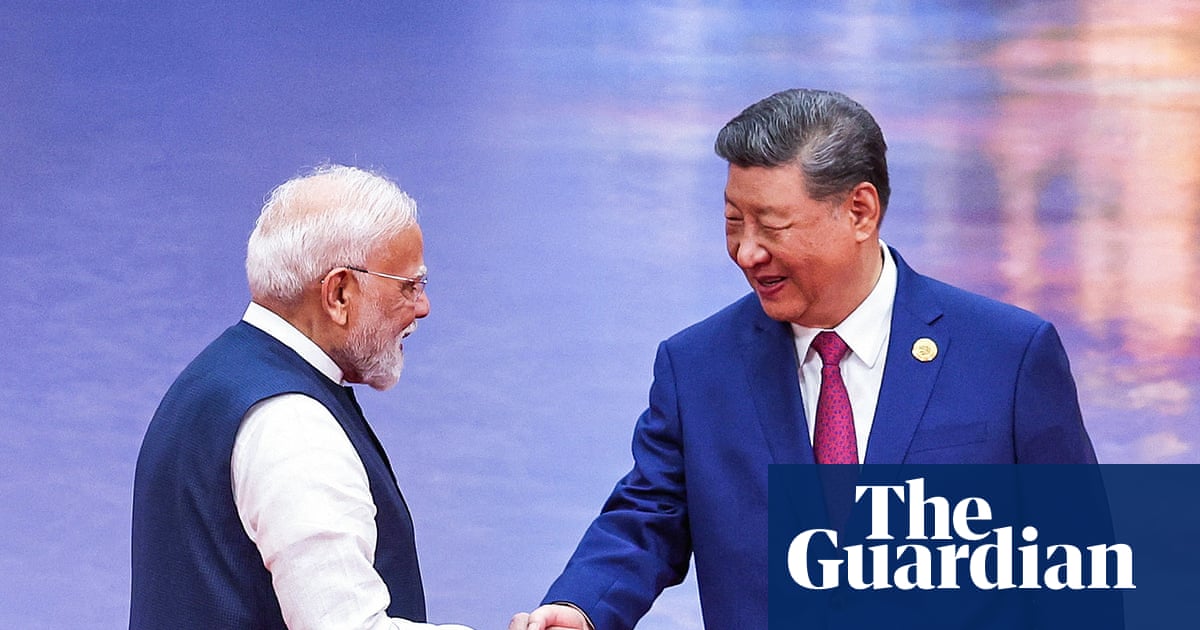They stood together like old friends, heads thrown back in jovial laughter, clutching one another’s hands affectionately. Except this was no ordinary gathering of three men, but a meeting of three of the most powerful non-western leaders: Vladimir Putin, Xi Jinping and Narendra Modi.
The overt displays of intimacy were widely regarded by observers as a telling message of defiance aimed at their western counterparts, in particular Donald Trump, who just a few days earlier had slapped India with 50% import tariffs, among the harshest of the US president’s trade penalties.
“India likes other great powers to know that New Delhi has options,” said Christopher Clary, an associate professor of political science at University at Albany, State University of New York. “One advantage of being in lots of clubs is you can make high-profile entrances to those clubs if you’re upset with how things are going in other relationships.”
This was Modi’s first visit to China in seven years and the hostilities that had come to define the countries’ relationship in recent years were nowhere to be seen. Instead, as the Indian prime minister arrived in China for the Shanghai Cooperation Organisation summit, he received a far more effusive welcome from the Chinese premier than most guests were granted.
The leaders’ brotherly encounter in the city of Tianjin did not go unnoticed in the Oval Office. Hours after the meeting, Trump went on another tirade against India, calling trade with the country a “one-sided disaster”, while his trade adviser Peter Navarro said in a social media post: “It is a shame to see Modi getting in bed with Xi Jinping and Putin. I’m not sure what he’s thinking.”
Even a year ago, such a scene between Modi and Xi was difficult to imagine. The two countries had remained in a hostile military standoff since 2020 after China’s rapid encroachments and troop incursions along its mountainous Himalayan border with India led to a violent clash between soldiers on the two sides.
It was followed by a mammoth mobilisation of military personnel, infrastructure and weapons along both sides of the border. Anti-China sentiment ran rampant in India, with hundreds of Chinese apps – including TikTok – banned and Chinese companies prevented from investing in India.
The US had seized upon the tensions to cultivate its close ties with India further, viewing the country as a critical counterweight to China’s rise.
Yet Trump’s own foreign policy position has accelerated something of a geopolitical repositioning. The US, once seen as an unshakable ally to India, is now viewed in New Delhi as a turbulent, even hostile adversary.
The double tariffs on India, which Trump announced without warning, appear to be a punishment after falling out with Modi, who refused to credit the US president with halting possible nuclear war between India and Pakistan in May. Particular umbrage was taken in New Delhi at Trump’s attempts to use tariffs to shape India’s policies.
Meanwhile, China has observed the alienation of New Delhi and Washington with overt glee and made it clear its priority now is a complete normalisation of Indo-Chinese ties. During Modi’s China visit, he and Xi agreed to friendlier relations, which include stabilising their border and reopening their economies to each other. Speaking on Sunday, Xi said it was “vital to be friends, a good neighbour, and the dragon and the elephant to come together”.
As analysts emphasised, the beginning of a rapprochement between India and China pre-dated Trump’s second term. Nonetheless, the prospect of a second unpredictable Trump term had been seen by many as a driver for China’s sudden willingness to discuss disengagement with India.
“This meeting was a partial response to Trump’s tariff tantrum,” said Clary. “The core reality for India is that it does not have enough military capability to be confident of how an India-China fight would go. In this Trumpian world, India may not be able to find an outside ally that it can depend on and so it needs to make sure the India-China relationship is calm.”
Before the 2020 clashes, Modi had been seen as gung-ho in strengthening the India-China relationship, hosting Xi in India just a few months after being elected prime minister in 2014. Harsh V Pant, a professor of international relations at King’s College London’s India Institute, said it was likely the two leaders would try to revert the relationship to how it had been five years ago, despite the border remaining a challenge.
Even with the risk of infuriating its western allies, analysts emphasised India had a lot to gain from bettering ties with China. Much of India’s manufacturing, which Modi is trying to boost, is reliant on materials and rare earths from China. China, meanwhile, stands to gain economically if it regains access to India’s market.
However, Pant emphasised that there were still significant limitations on the India-China relationship beyond the border tensions. China remains a major backer and supplier of weapons to Pakistan – widely seen as a way to keep India’s regional power in check – and it was Chinese jets and weaponry that were used against India during the India-Pakistan hostilities in May.
“It would be a mistake to view this as some kind of a grand rapprochement between India and China,” he said. “In India, the trust deficit with China is still very, very high and there are enough pressure points that will keep the relationship a bit tenuous.”
Source link
